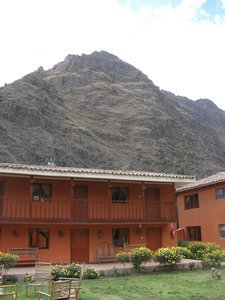Advertisement
Published: September 9th 2009

 Photo 16
Photo 16
Ollantaytambo LodgeOn Thursday 08/27/09 I woke up feeling sick and weak. We got dressed, went to the hotel’s cafeteria for breakfast, and then I just collapsed in one of their lounge couches. I’m not a whiner and have a high threshold for pain and fatigue, so if I say I need to rest, it’s because I REALLY need it. Ben and Cathy were good sports and watched TV for about three hours while I napped, the meds doing their work. I woke up feeling better and with enough energy to climb the archeological site of Ollantaytambo. The town is noted for being the one with the oldest, continuously inhabited Inca structures.
We walked over to the archeological site and were soon met by a guy offering his services as a guide. We negotiated a 1½ hour private tour in English for $20, I think. Our guide explained that Ollantaytambo, located at 2,700 meters (8,854 feet) a.s.l. and built of granite (like Machu Picchu), was an urban, religious, and agricultural Inca city. It’s noteworthy for being located halfway in the Sacred Valley, midpoint between Pisac and Machu Picchu.
Archeologists estimate that it took about 4,000 people 65 years to build the

 Photo 18
Photo 18
Ollantaytambo Lodgereligious and ceremonial site we were visiting. The urban site for the regular common citizens was located in the lower grounds. These “commoners” dwellings from Inca times are currently occupied by their descendants, the present-day Ollantaytambo people.
Through our visits to the various archeological, cultural, and historical sites in Cuzco and nearby areas we learned that the Incas only built during the dry season (winter), roughly between April-October; the rest of the year was dedicated to other religious, social, and agricultural activities.
At Ollantaytambo, we saw the Temple of the Sun, the Inca’s throne, ceremonial rooms, water fountains, aqueducts. The site exhibits traditional Inca architecture: No mortar; tightly fitting, hand carved stones; trapezoid-shaped walls and entry ways. The knobs on the stones, which I had noticed at other archeological sites, were used as handholds to help move the huge stones.
Being a sacred Inca place, the site was destroyed by the Spaniards, to then force the locals to convert to Catholicism. Stones that used to be part of walls up high in the Temple of the Sun or other structures are now scattered individually on the various terraces of the site. A number of walls still stand,

 Photo 17
Photo 17
Ollantaytambo Lodgethough; about 65% of the structures are original construction and 35% reconstructed or restored.
After visiting the site, we went looking for lunch. We settled for El Chasqui (Chasquis were the messengers or couriers of the Inca Empire), just down the road on the way to Ollantaytambo’s main plaza. Cathy had Spaghetti in pesto sauce, I had Sopa a la minuta, and ben had Palta a la vinagreta and a Steak sandwich.
After lunch, we headed back to Ollantaytambo Lodge to get our bags. Lourdes, the concierge, arranged for a taxi to take us to Cuzco, about 45 minutes away by car. We got back to the Inkarri, checked in, and went back out to get a quick bite at Yajúú. Then called it a night; we were exhausted!
Advertisement
Tot: 0.169s; Tpl: 0.016s; cc: 13; qc: 58; dbt: 0.1173s; 1; m:domysql w:travelblog (10.17.0.13); sld: 1;
; mem: 1.2mb

 Photo 16
Photo 16
 Photo 18
Photo 18
 Photo 17
Photo 17














